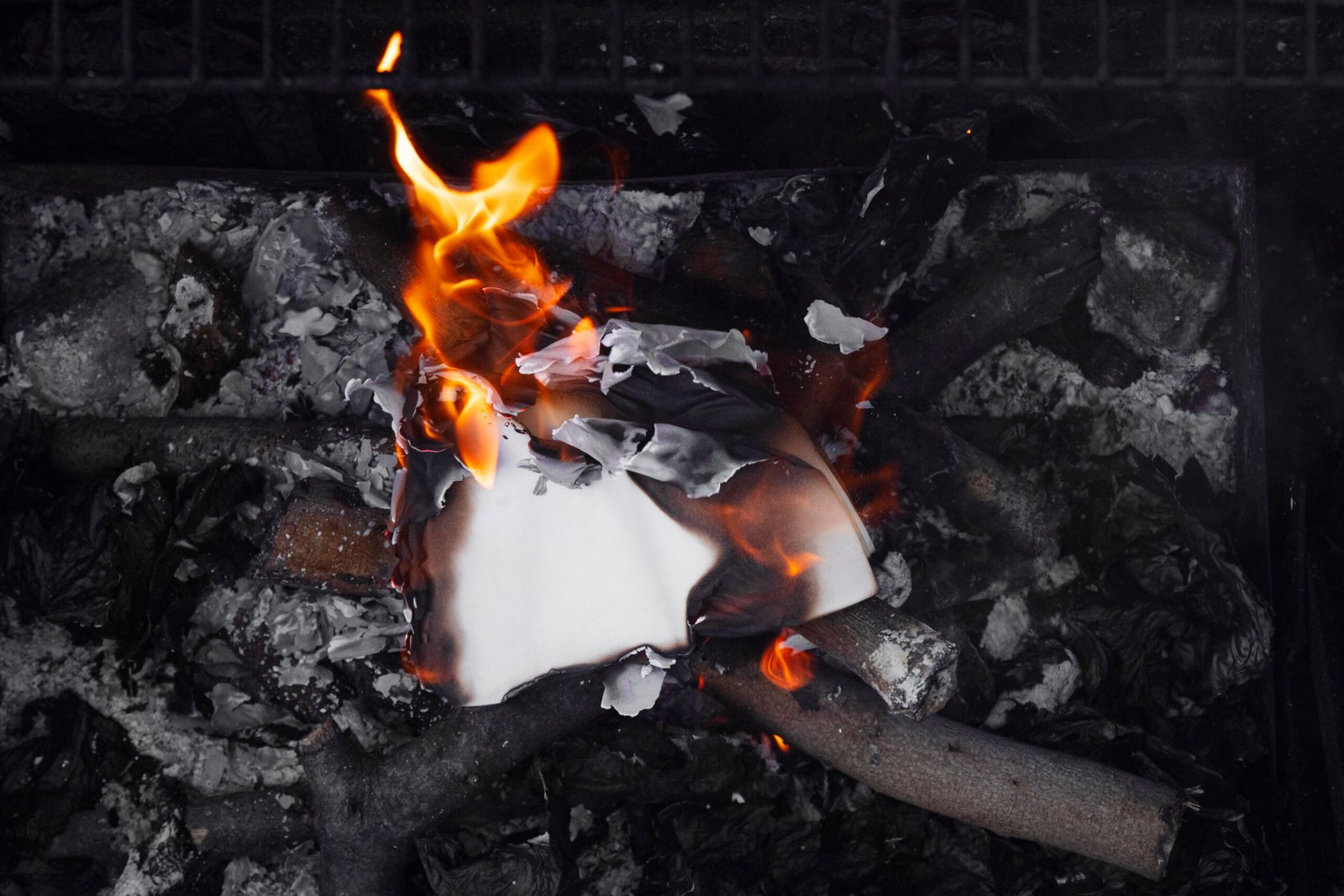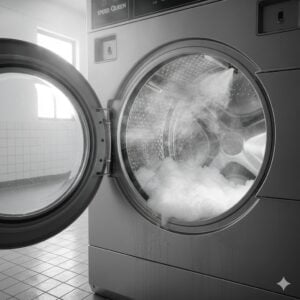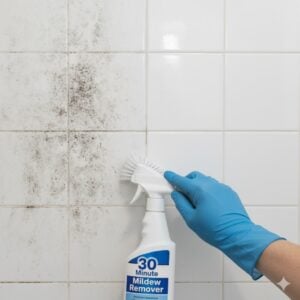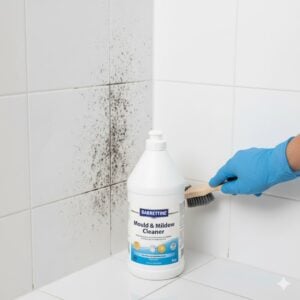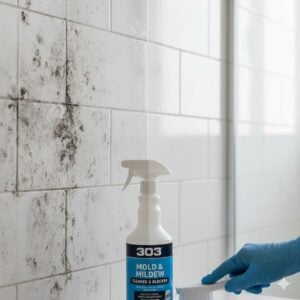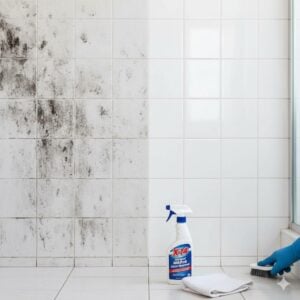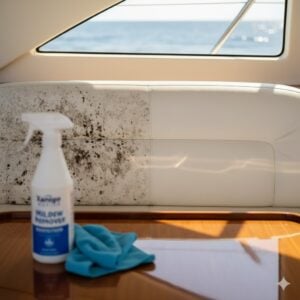Hello there! Dealing with fire damage can be a daunting task, but understanding the essentials of fire damage cleanup is the first step towards restoring your home swiftly and efficiently. Knowing the right tips and techniques is crucial, not just for the aesthetics of your home, but for the health and safety of its inhabitants. That’s why we’re here to share five indispensable fire damage cleanup tips to help you get your home back to its former glory quickly. Let’s dive into these lifesavers that can make a world of difference in your restoration efforts.
Table of Contents
Toggle#1 Immediate Actions Post-Fire
In the immediate aftermath of a fire, the chaos and damage can seem overwhelming, yet it’s crucial to prioritize actions that ensure both the safety of the inhabitants and the integrity of the home. Here’s a comprehensive guide to the immediate steps you should take following a fire incident, aimed at laying a solid foundation for the cleanup process and mitigating further damage.
First and foremost, safety is non-negotiable. Before re-entering your home, it’s essential to get a green light from firefighters or relevant authorities, confirming that it’s safe to do so. This includes ensuring the structural stability of the building and that there are no lingering dangers such as hot spots that could reignite. Once inside, wearing protective gear such as gloves, masks, and even eye protection is imperative to safeguard against inhaling or coming into contact with harmful soot, ash, or potentially toxic substances released during the fire.
Ventilation plays a pivotal role in the initial stages of fire damage cleanup. Opening all windows and doors accelerates the dispersal of smoke, soot, and any hazardous gases. If electricity is safely available and it has been approved by the authorities, setting up fans to further facilitate air circulation can help in reducing smoke odor and particles from the environment. Proper ventilation also aids in drying out areas affected by water used to extinguish the fire, thereby preventing the onset of mold and mildew.
Removing water and drying the premises should be addressed promptly. Firefighting efforts often result in significant water accumulation, which, if not dealt with quickly, can lead to secondary water damage and mold growth. Using pumps, vacuums, or professional water extraction services is crucial in removing standing water. Dehumidifiers and air movers should then be employed to dry out the property thoroughly. It’s a balancing act between drying the property and not causing additional damage by overly aggressive methods.
The assessment of structural damage is next. Fire can compromise the integrity of buildings, making certain areas unsafe. Inspecting for and identifying these damages early can prevent accidents and inform the scope of necessary repairs. Look for signs of structural weakening, such as cracks in walls, damage to support beams, or compromised roofing. Engaging structural engineers or building inspectors can provide a detailed analysis and recommendations for ensuring the building’s safety before proceeding with in-depth cleaning and restoration.
Lastly, securing the property is a critical step not to be overlooked. Fires can leave homes vulnerable to theft, vandalism, or further damage from the elements. Boarding up missing windows, doors, and any breaches in the exterior will protect the property in the interim period before repairs can be made. Tarping over damaged roofs is a stopgap measure to prevent water ingress from rain.
These initial actions lay the groundwork for a comprehensive cleanup and restoration process. They emphasize safety, prevent further damage, and set the stage for the detailed cleaning, repair, and eventual return of the home to its pre-fire condition. Each step is pivotal, ensuring the well-being of the inhabitants and the structural health of the property, guiding homeowners through the daunting journey of fire damage recovery.
#2 Soot and Smoke Removal Techniques
The removal of soot and smoke is a critical phase in fire damage cleanup, addressing not only the visible aftermath but also the lingering odors and potential health hazards associated with these byproducts. This phase requires a blend of precision, knowledge, and sometimes, professional intervention to ensure thorough cleanliness and safety of the environment.
Soot, a powdery residue left by burnt materials, can coat surfaces and belongings. Its removal starts with vacuuming to avoid smearing and pushing the soot deeper into materials. A vacuum with a HEPA filter is preferred for its ability to trap fine particles. Direct the nozzle over the soot-covered surfaces without making contact, as touching can grind the soot into the fabric, walls, or flooring, making it harder to clean. Following vacuuming, a dry chemical sponge, specifically designed to absorb soot without water, is used to wipe down surfaces. These sponges can be trimmed to expose fresh surfaces for continued use.
Smoke removal, on the other hand, deals with the pervasive odors that penetrate materials. This process often involves thermal fogging, a technique that neutralizes smoke molecules. The fog, generated by a thermal fogger, penetrates the same pathways the smoke did, effectively neutralizing odor-causing particles. It’s important that this task is performed by professionals, as the compounds used require knowledge of proper application techniques and safety measures.
For textiles such as curtains, carpets, and upholstery, specialized laundering or steam cleaning may be necessary. Items should be assessed individually to determine the most effective cleaning method. In many cases, professional cleaning services that specialize in post-fire restoration have the equipment and expertise to salvage these items.
Hard surfaces like countertops, walls, and ceilings require a different approach. A cleaning solution that often includes a mix of detergent and degreasers can be used to break down and remove soot and residue. It’s crucial to test these solutions on a small, inconspicuous area first to ensure they do not cause damage. For painted walls or delicate surfaces, the approach needs to be gentler, possibly requiring a professional’s touch to avoid further damage.
In some instances, the HVAC system can harbor smoke and soot, circulating these harmful particles throughout the home. Cleaning and replacing filters, and professionally cleaning the ductwork, can prevent recontamination and ensure the air quality is safe for inhabitants.
Despite the effectiveness of these methods, some items may be beyond cleaning and restoration, requiring careful evaluation and, if necessary, disposal. This discernment is crucial in preventing health issues and ensuring a thorough cleanup.
Engaging professionals for soot and smoke removal can often be the most efficient choice, given their experience, techniques, and equipment designed specifically for post-fire restoration. They can navigate the complexities of this process, ensuring that the home is not only visually restored but also safe and healthy for its occupants. This phase of cleanup is exhaustive but fundamental, as it addresses both the visible signs of damage and the invisible, lingering effects of a fire.
#3 Salvaging and Cleaning Personal Belongings
Salvaging and cleaning personal belongings after a fire is a painstaking process that requires attention to detail and knowledge of different materials to avoid causing further damage. Each type of item requires a specific approach based on its material, level of damage, and the type of soot or smoke residue it has been exposed to. Here’s a guide to handling the cleaning of various items:
For electronics, it’s crucial to avoid using them until they have been professionally evaluated and cleaned. Fire can damage the internal components, and soot can conduct electricity, leading to potential hazards. Professionals will often disassemble the items, clean each component with a special solution, and ensure they are completely dry before reassembly.
When dealing with clothing, the first step is to shake out each item to remove any loose soot. It’s advisable not to wash these items in your regular washing machine, as soot can transfer to the machine and contaminate subsequent loads. Instead, using a heavy-duty detergent and multiple washes may be necessary, and some items might require dry cleaning or specialized treatment to remove odors and stains fully.
Furniture poses its own set of challenges. For upholstered pieces, vacuuming with a HEPA filter to remove soot without pushing it deeper into the fabric is the first step. Depending on the material, steam cleaning or a professional furniture cleaning service might be needed to address both stains and odors. Wood furniture may require cleaning with a mild detergent and water, followed by a wood conditioner to restore its finish.
Books and paper products are particularly susceptible to smoke damage and may absorb odors. While it’s difficult to remove all traces of smoke, airing out pages and using absorbent materials like baking soda can help reduce smells. In some cases, professional document restoration services are needed to salvage important documents.
For hard surfaces like dishes and cookware, washing with a soapy solution and possibly a dilute vinegar solution can help remove soot and neutralize odors. It’s important to clean these items thoroughly, as residues can be harmful if ingested.
Photographs require gentle handling. If they are not stuck together or brittle, they can be carefully wiped with a soft cloth. However, water or chemical cleaners should be avoided to prevent further damage. Professional photo restoration services can offer more comprehensive recovery techniques for valuable or irreplaceable photos.
Throughout this process, it’s essential to assess the cost of cleaning versus replacement. Some items, particularly those with sentimental value, may be worth the effort of professional restoration. However, for others, the cost of cleaning may exceed their value, making replacement a more sensible option.
This detailed approach to salvaging and cleaning personal belongings after a fire is critical. It ensures that items are not only cleaned but preserved, maintaining their value and significance to the owners. By understanding the specific needs of different materials and employing appropriate cleaning methods, it’s possible to reclaim much of what was affected by the fire, turning a situation of loss into one of recovery and restoration.
#4 Dealing with Water Damage and Mold
Dealing with water damage and mold is an integral part of the fire damage cleanup process. Often, the water used to extinguish the fire can lead to additional issues, including structural damage and mold growth, if not promptly and properly addressed. Understanding the steps to mitigate water damage and prevent mold can save homeowners from future headaches and expenses.
Immediately after a fire, it’s essential to remove any standing water as quickly as possible. This can be done using pumps or wet-dry vacuums, but care must be taken to ensure electrical safety before using any electrical equipment. Fast removal of water helps to limit the extent of water damage and reduces the risk of mold formation.
After the water is extracted, drying out the home becomes the next critical step. Industrial-grade dehumidifiers and air movers are effective in removing moisture from the air and materials within the home. This process can take several days and requires constant monitoring to ensure that humidity levels are steadily decreasing. It’s important to dry out the home thoroughly to prevent mold and mildew, which can start to grow within 48 hours in damp conditions.
Once the home is dry, inspecting for mold is necessary. Mold can hide in walls, under carpets, or in other hard-to-see areas. If mold is found, it must be addressed immediately. Small areas of mold can be cleaned with a solution of water and detergent, but larger infestations or mold in HVAC systems require professional remediation. Professionals have the equipment and chemicals necessary to safely and effectively remove mold and prevent its return.
Preventive measures should also be taken to avoid future mold growth. This includes fixing any leaks in the roof or plumbing and ensuring the home is well-ventilated. Using mold-resistant paint can add an extra layer of protection on walls and ceilings. Furthermore, maintaining a good air flow and keeping humidity levels within the home between 30% and 50% will help to deter mold growth.
Additionally, it’s crucial to clean and disinfect all areas affected by water to prevent the spread of bacteria and other harmful organisms that can thrive in moist environments. Non-porous surfaces can be cleaned with water and detergent, then disinfected with a solution recommended by health authorities. Porous materials, however, may need to be discarded if they cannot be thoroughly cleaned and dried.
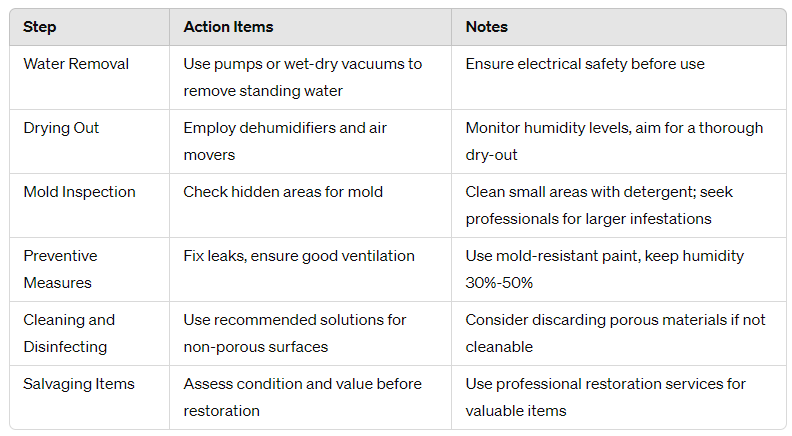
Salvaging items affected by water damage requires a careful approach. Important documents, books, and photographs can sometimes be saved through air drying, freezing, or professional restoration services. However, it’s vital to assess each item’s condition and value before deciding on the restoration effort.
The process of dealing with water damage and mold after a fire is comprehensive and requires immediate and sustained effort. Successfully navigating this phase not only restores the home to a safe and healthy environment but also prevents long-term damage that could compromise the structure and indoor air quality of the home. With careful attention to drying, cleaning, and preventive measures, homeowners can effectively mitigate the impacts of water damage and mold following a fire.
#5 Renovation and Reconstruction Tips
Renovation and reconstruction after a fire are pivotal steps in turning a damaged house back into a home. This phase not only requires a focus on repairing the structural damages but also on making choices that ensure the safety, functionality, and aesthetics of the living space for years to come.
Firstly, it’s essential to prioritize areas for repair and renovation. Structural safety is paramount. Engage a professional to assess the integrity of the home’s foundation, beams, and supports. Electrical systems, plumbing, and HVAC systems should be next on the checklist, as fire can cause hidden damages that might not be immediately apparent but could lead to serious issues if not addressed.
Once the critical systems and structural integrity have been secured, attention can shift to the interior. Smoke and soot can infiltrate walls, ceilings, and even the structure of the house, necessitating thorough cleaning before any cosmetic repairs. This might include replacing drywall, re-insulating parts of the home, and ensuring that all surfaces are primed and sealed to lock in any remaining odors before repainting or finishing.
Choosing the right materials for renovation is crucial. Fire-resistant materials, such as fire-retardant paint, non-combustible roofing materials, and treated wood, can enhance the home’s resilience against future incidents. In addition, consider the use of modern, durable materials for flooring, countertops, and fixtures that can withstand wear and offer a fresh, updated look.
Finding the right contractor is just as important as selecting materials. Look for professionals with experience in post-fire renovations, as they’ll have the necessary knowledge to handle the unique challenges these projects present. Ensure they are licensed, insured, and have a good track record with previous clients. Communication is key—your contractor should understand your vision for the home and be able to offer practical advice to make those ideas a reality.
As the renovation progresses, keep detailed records of all work done and materials used. This documentation can be invaluable for insurance purposes, future property sales, or even just for your peace of mind. Additionally, this is an opportunity to make upgrades or changes that you’ve always wanted, whether it’s adding more natural light with new windows or reconfiguring the layout to better suit your lifestyle.

Renovation and reconstruction after a fire offer a chance to rebuild not just the structure of a home but also the life that was lived inside it. By focusing on safety, choosing the right materials and contractors, and carefully planning each step, homeowners can navigate this challenging process with confidence. The end result—a safe, beautiful, and functional space—can provide comfort and satisfaction that makes the journey worthwhile.
Why Bio On is Your Ideal Partner for Fire Damage Cleanup
In the aftermath of fire damage, the restoration journey requires expertise, precision, and compassion—qualities that Bio On delivers. Specializing in fire damage cleanup, mold remediation, and comprehensive deep cleaning services, Bio On offers a holistic approach to restoration. Utilizing state-of-the-art technology and advanced techniques, each project is handled with the utmost care, ensuring that homes are not only visually restored but also safe and healthy environments for inhabitants.
The team’s quick response time, attention to detail, and commitment to customer satisfaction make Bio On a trusted partner in navigating the complexities of post-fire recovery. For those seeking expert guidance and efficient solutions, Bio On stands as a beacon of hope, transforming the daunting task of restoration into a seamless, worry-free process.
Conclusion
The journey of restoring a home after fire damage is intricate and multifaceted, encompassing immediate cleanup, soot and smoke removal, personal belongings restoration, water damage mitigation, and comprehensive renovation. Each step is crucial in ensuring the home returns to its pre-damage state, not just in appearance but in safety and functionality. Bio On’s expertise in navigating these complex processes offers peace of mind and reliable results. For those facing the challenge of fire damage restoration, reaching out to Bio On through the Whatsapp button for a free consultation provides a pathway to reclaiming their space with confidence and support.








